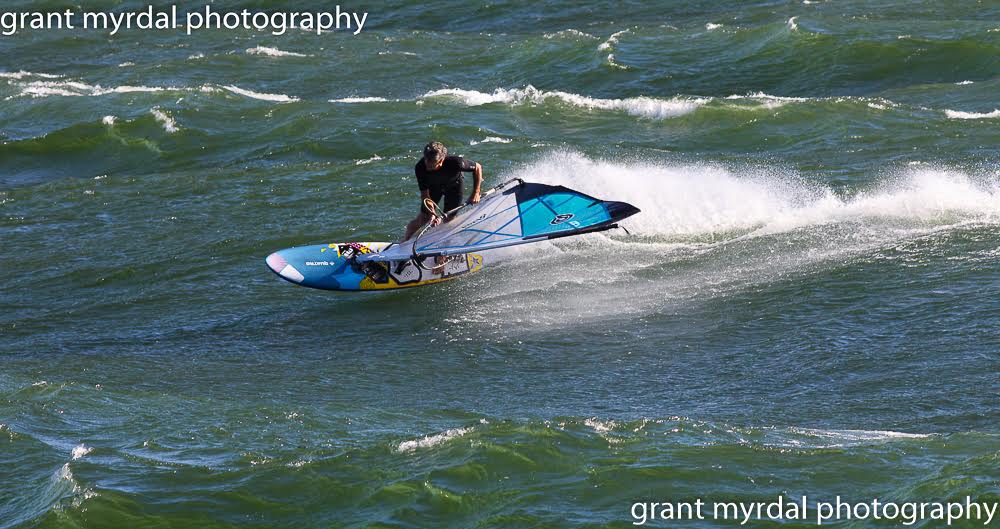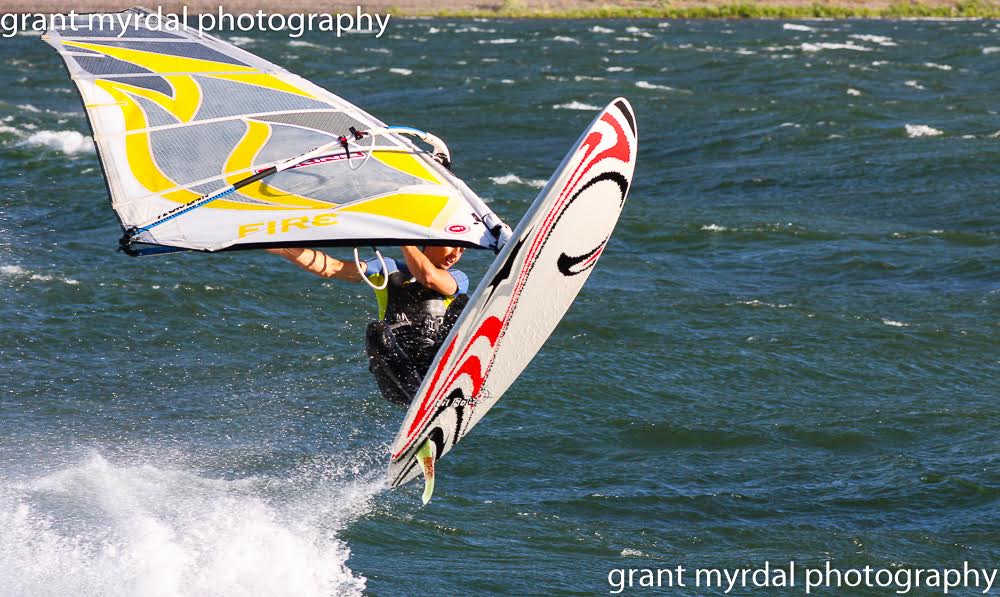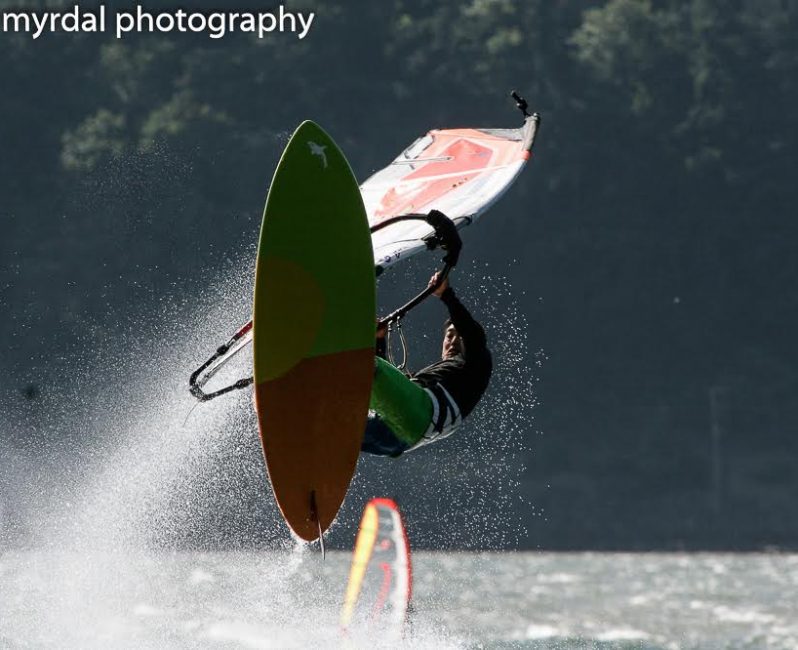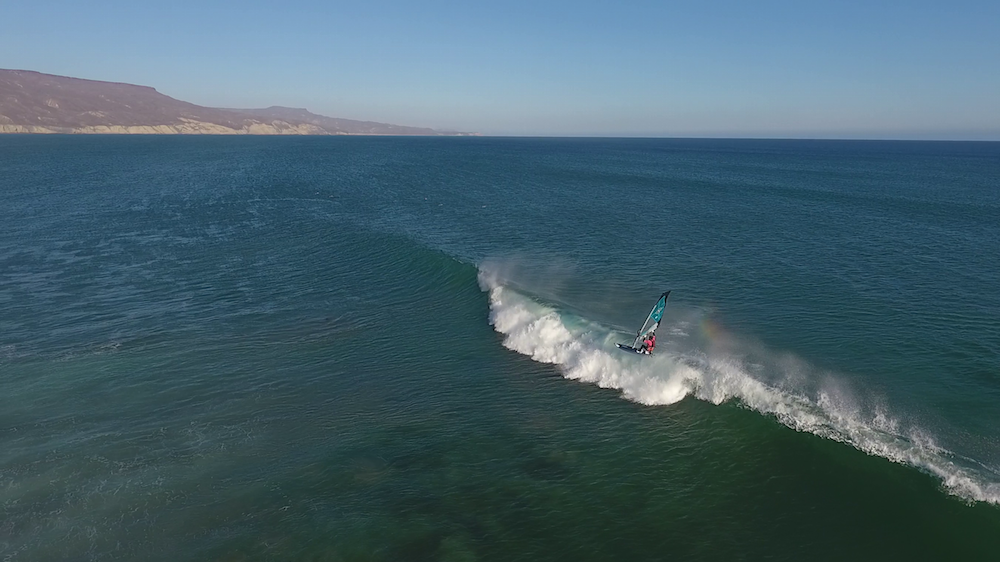If you spend as much time up on Mount Hood in winter as I do you probably know a few Columbia River Gorge wind hounds. They share a lot in common with powder hounds: that passion for intensity, the need for speed, a serious obsession with weather conditions. In fact, they may be even more obsessed with wind than we are with snow—and that’s saying something.
The windsurfing scene on the Columbia River in and around Hood River was pioneered three decades ago by a bunch of hard-core riders who fell in love with the way the prevailing westerlies stack up in the river there in summer time, creating huge waves perfectly designed for launching. The former timber town quickly became a magnet for windsurfers, and innovation flourished, on the river and in town. Sail and gear designers set up shop, the gear got better and better, and so did the riders.
John Akagi, one of the original Gorge Pioneers
These days the wind scene in the Gorge extends at least 100 miles, from Troutdale out to Arlington by way of the Hatchery and the Wall, a water wonderland for everyone from newcomers to top pros out on the water, with the lively nonprofit Gorge Windsurfing steering the sport’s local progression and development. The action seems to peak around August, but it’s lively all summer long, from June to September. Hard-core Mount Hood riders like John Loseth, Jeff Albright, Temira Lital, Rick Streedain, Kyle Skutch are all in the mix, along with many, many others. The rise of kiteboarding and stand up padding add to a lively subculture of wind fanatics both local and transient, the type of folks who can take a quick look at iWindsurf and tell you exactly how hard it is blowing and will be blowing, and exactly when it’s gonna get really good.
It all adds up to quite the show for Grant Myrdal, a former competitive surfer who spends his winters photographing snow hounds on Mount Hood and his summers shooting wind hounds in the Gorge. He follows Temira’s wind forecasts closely, and when conditions look good he drives from his horse farm in Bend out to the river, sets up on the beach in the nukin’ wind, plants his flag with great care so the wind won’t send it out in the the river, and goes to work in a dramatic landscape filled with all sorts of variations of light, angles and dynamic images. When you see his photos you can understand why he keeps coming back for more – and why the ever-increasing crews of Gorge wind riders keep coming back as well.
Wind Forecasting Guru Temira Lital
After years of admiring Grant’s photos and catching the occasional jaw-dropping glimpse of the mayhem from the beach in Hood River, I decided to take a closer look. I know a very little bit about windsurfing from my short-lived career as a wind-hound in the Adirondack lakes up upstate New York. But trust me, the sport has come a LONG way since then. The boards are lighter and more maneuverable, the sails far better designed, and the entry level skills of today are way beyond any proficiency I ever attained riding the equivalent of wooden skis with bear-trap bindings. I had to laugh as I drove out to the hatchery on the Washington side to meet up with Grant, thinking back to those days strapping that whale-like windsurfer to the roof of my whale-like 1972 Chevy Nova. Surf’s up, baby!
The first thing I noticed as an outsider in the Gorge was that the wind never seems to blow hard enough. Even when it’s blowing so hard you can barely stand up on the beach without getting blown over and any light item left unattended gets quickly blown away, riders are hollering over to Grant: “We need more wind!” Just like skiers: Yes, six inches of fresh is pretty sweet, but remember that time we got four feet? Now that was fun.
The second thing an outsider notices in the Gorge is that the good riders are really, really good. “That guy in the white helmet is flying, look at him go!” Grant hollered over the wind. “The good guys always go faster than anyone else, no matter what the wind is doing.”
They also throw some nice air when the waves stack up, and they make it look easy when they flip the rig to jibe (trust me—it isn’t).

We started off at the Hatchery, just downstream from Hood River on the Washington State side. Then the news came through that it was nuking out at the Wall so we decided to pack up and head East. For some reason, “nuking” is the preferred phrase for strong wind in the Gorge, which just happens to be located downstream from the hanford Nuclear Reservation. No connection between the two apparently—it’s just the word that has stuck, maybe just because of the way it sounds. Nukin and pukin, nucular and tubular.
The trees pretty much end on the trip out to the Wall, replaced by that sweeping, stark, wide-open landscape east of the Cascades. Hardy plants adapted to the wind, gorgeous stone walls on either side of the water, huge trains ripping cross-country, massive barges throwing spray, powerful sun and good, strong wind. A couple dozen windsurfers were out doing their thing, and the wind was strong but slightly twisted, coming from out of the Southwest instead of the West as preferred. Some riders were taking it even further east, driving out to Arlington; others were staying put and waiting for the right moment to dive in.
While we were debating whether to stay or move east, some guy launched into a beautiful 360 and we decided it was good enough where we were. I dug out a picnic lunch and wedged myself in between some rocks out of the sun and wind to admire the show while Grant set up his flag and started shooting the action.

While we were out at the Wall, Grant and I caught up with John Akagi, one of the early pioneers of windsurfing in the Gorge, and I managed to get a little oral history from a guy who has seen the evolution of the scene from the inside.
Akagi has been riding wind for more than 30 years. He came to Oregon for the first time in 1988 and quickly hooked up with a crew of wind hounds obsessed with the Gorge and the possibilities it offered:
We were like the early pioneers. We came out to that cove down there and the next launch down. That’s where we used to sail, and we were just kid on discovering what was here. We started out of Hood River, and the Hatechery wasn’t even happening yet. And then after a few years we discovered the Hatchery and we started sailing there. Doug’s Beach was founded by Doug Campbel, who ownded Hood River Windsurfing, and that’s where a lot of people came in the early days.
Hood River was hopping with windsurfers. All the players were here, all the manufacturers built something in Hood River. There was a wetsuit company, sail companies, people were making boards here. There was none of this off-to-China stuff. There were building it here. It was the windsurfing capital, along with Maui. A lot of people came here for windsurfing. It was pretty cool.
We always had to battle the railroads. We were always asking them, Where can we launch? We used to go to 3-Mile Canyon and on the other side of 3-Mile Canyon. But you had to cross the railroad tracks there, and that’s trespassing. But we founded a lot of spots out here, and a lot of them are still the spots people want to go.
The wind is an addiction. Everybody does a computer model, so everything is based on the model, and you try to interpret the information and predict what’s coming. You’re always looking for that perfect day, and when you get it, it is the best.
{igallery id=1891|cid=80|pid=2|type=category|children=0|addlinks=0|tags=|limit=0}
You can scroll through all of Grant Myrdal’s 2016 wind photos from the Gorge here.
Last modified: September 21, 2016




